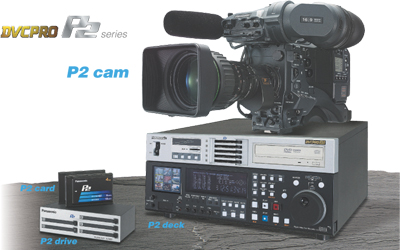The core technology behind Panasonic's ING is the SD memory cards, which have become the world's leading compact, portable high-capacity storage. These are in use across a rapidly growing range of consumer and professional markets. For the broadcast industry, with its large and intensive storage requirements, Panasonic has packaged four 1GB SD memory cards onto a single, standard PCMCIA card. Called a P2 card, which means Professional Plug-in card, this compact, portable media replaces the role of the tape cassette in a traditional news environment.
"ING is redefining the whole acquisition process and workflow, providing a true IT "front end" to the production process" said Robert Pascher, Manager, European Broadcast Marketing, Panasonic Broadcast. "It is a fundamental technology shift that is also going to deliver significant savings to broadcasters and news organisations in terms of speed, operational efficiency, increased ruggedness of equipment , no moving parts, reduction in consumable media and total cost of ownership."
At IBC Panasonic unveiled a range of DVCPRO P2 series products, which included:
 P2 card. A single P2 card stores 18 minutes of DVCPRO at 25Mbps and 9 minutes at DVCPRO50. A key feature of the P2 card is the rapid transfer rate. A 4GB P2 card has a maximum of 640Mbps transfer rate enabling DVCPRO and DVCPRO50 to be downloaded at faster than real time speeds. Panasonic also announced that further versions of the P2 card will be introduced as higher capacity SD memory cards are launched.
P2 card. A single P2 card stores 18 minutes of DVCPRO at 25Mbps and 9 minutes at DVCPRO50. A key feature of the P2 card is the rapid transfer rate. A 4GB P2 card has a maximum of 640Mbps transfer rate enabling DVCPRO and DVCPRO50 to be downloaded at faster than real time speeds. Panasonic also announced that further versions of the P2 card will be introduced as higher capacity SD memory cards are launched.
- P2 cam. This comes up with five P2 card slots giving a total potential record capacity of 90 minutes with 4GB P2 cards at DVCPRO. With no moving parts, the camcorder is extremely resistant to shock and vibration and has a lower power consumption compared to previous tape systems. Panasonic showed a 2/3" IT 3CCD camcorder with 600,000 pixels at IBC. A key feature of the camcorder is the ability to select on the camera DV, DVCPRO, or DVCPRO50 as the recording format. Pictures are also stored on the P2 card with a MXF "wrapper" ensuring broadcast open standard IT compatibility for file transfer. New P2 cards "hot swappable". In addition the P2 cam features SDI/IEEE1394/USB2.0 interfaces and 3.5" LCD monitor. It is prepared with its option slots for Wireless-LAN and Proxy Video applications.
- P2 deck. The P2 deck links the ING system into the standard broadcast infrastructure. Using a P2 deck capable of handling five P2 cards and with interfaces and operation similar to a VTR, on-air transmission is possible from an OB truck. Clip management and simple playlist function are available on the P2 deck, which includes a LCD monitor. A DVD-RAM/R drive can be installed in an optional 5.25" bay slot to archive footage copies onto disk.
- P2 drive. P2 drive is a five P2 card reader/writer equipped with a USB 2.0 interface that links the cards into a PC. This would be one of the routes linking ING to newsroom networks. As with the PC, there is no need for digitising and material is immediately available for editing and file transfer. Once footage is on the network it can be shared by browsing clients, servers and non-linear editors.
The P2 card can handle DV, DVCPRO, DVCPRO50 and can also record and play DVCPROHD. As higher SD cards become available, new DVCPRO50 and DVCPROHD equipment will be developed to accompany them.
At IBC, Panasonic confirmed that first DVCPRO P2 series equipment will start shipping to customers in the second quarter of 2004.
ends